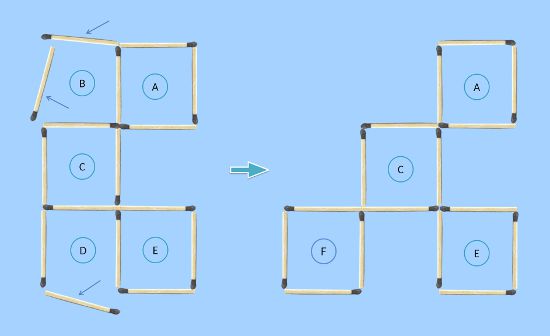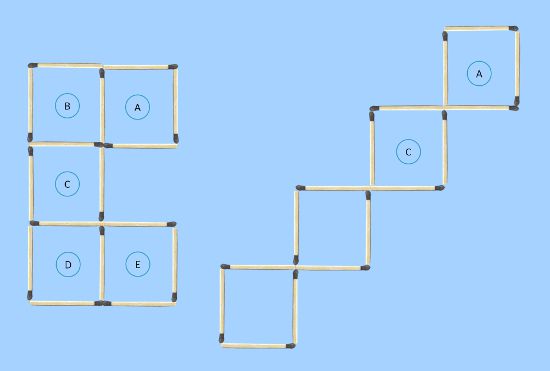
Move 3 matches to make 4 squares from 5 squares matchstick puzzle
Move 3 matches to make 4 squares from 5 squares in the matchstick puzzle figure.
Every matchstick must be a side in a square in the final solution.
Time to solve 15 minutes.

Comment
Give it a try—it will sure be interesting to solve.
In fact, most of the matchstick puzzles, especially the 5 squares puzzles, are fun to solve. This matchstick puzzle is one of the more interesting 5 squares puzzles.
When you are ready, go through our step by step solutions. The puzzle is solved in two different ways,
- by structural analysis and reasoning, and
- by End State Analysis Approach.
First Solution to the 5 squares matchstick puzzle - Move 3 matches to make 4 squares from 5 squares: By structural analysis and reasoning
Solution stage 1: Initial Problem analysis and Conclusions
For convenience, the puzzle figure is shown again.

First action is to count the total number of sticks. 16 sticks are enough to make 4 squares of equal size with no stick common to two squares. So,
Conclusion 1: The 4 squares in the solution figure must be independent of each other with no common stick between any two squares.
This is the first important conclusion made by analyzing the number of sticks required.
Next observation,
Fact: Movement of any single stick from the puzzle figure will destroy at least 1 square.
If a common stick is moved, 2 squares will be destroyed with at least 5 sticks not forming any side of a square. This will make solution impossible.
Conclusion 2: Moving any common stick is not an option.
Solution stage 2: Move 3 matches to make 4 squares from 5 squares: Conclusions by analyzing the number of squares to be destroyed
From analysis of number of squares,
Conclusion 3: To get 4 squares from 5 squares in 3 stick moves, 2 squares to be destroyed and 1 square to be created.
Reasoning: as common stick move cannot be considered, any of the three stick moves can destroy AT MOST 1 square. Moving only a common stick can destroy 2 squares, isn’t it?
So the critical question arises,
Question: How to destroy 2 squares in 3 stick moves?
Understanding fully how this happens should make the solution clear.
Consider first the fact,
Fact: As moving a common stick is not acceptable, moving 1 stick destroys only 1 or 0 square.
Simple math: Break up of 2 as a sum of three numbers each at most 1: ⇒ 2 = 1 + 1 + 0. The numbers represent the number of squares destroyed in 1 stick move.
Translate the result to make an important conclusion,
Conclusion 4: Number of squares destroyed must be: ⇒ 1 square by 1 stick move, 1 square by 1 stick move and 0 square by 1 stick move.
In other words, ONLY 1 SQUARE TO BE DESTROYED in 2 stick moves and second square to be destroyed by 3rd stick move.
Not a doubt.
Take a pause now to verify conclusions made.
Solution stage 3: Move 3 sticks to make 4 squares from 5 squares: Conclusions by analyzing creation of a single square
In 3 stick moves 2 squares are destroyed till now (just imagine, it is visualization).
How about creating the new square? How can a new square be created using 3 free sticks?
Simplest way to create a new square is,
Conclusion 5: On one existing side, complete the other 3 sides of a square with 3 free sticks moved.
Take a pause again to decide that this is the only way.
So then,
Conclusion 6: The existing single side must be a hanging stick created in 3 stick moves, isn’t it?
This gives a new clue to the mystery,
Conclusion 7: BEFORE CREATION OF THE NEW SQUARE, a single hanging stick has to be created in 3 stick moves.
Solution stage 4: Move 3 matches to make 4 squares from 5 squares: Conclusions by hanging stick and stick move analysis
To be totally clear, the single hanging stick will be created only after the three sticks are moved away from their places in the puzzle figure. It is the NET RESULT BEFORE CREATION OF THE NEW SQUARE.
Who created this single hanging stick? Which stick move produces this so very helpful result?
This is the time to recall the result of Conclusion 4,
Conclusion 4: ONLY 1 SQUARE TO BE DESTROYED in 2 stick moves and second square to be destroyed by 3rd stick move.
How can 1 square be destroyed in 2 stick moves? Moving what type of sticks (by placement in figure) would do that?
It is possible only if,
Conclusion 8: The first stick move destroys 1 square and creates 1 hanging stick still attached to the puzzle figure. This second hanging stick from an already destroyed square is moved as the second stick.
Think. Is it possible any other way?
At last, a clue on what type of 2 sticks would destroy only 1 square when moved,
Conclusion 9: The 2 sticks that will destroy only one square when moved must be two CORNER STICKS OF A SQUARE IN THE PUZZLE FIGURE.
Think. Is it really true?
Thinking in abstraction
Take a pause and realize that all analysis and conclusions till now didn’t refer to OUR PUZZLE FIGURE.
Abstract puzzle specification: All are true for any general matchstick puzzle that needed the destruction of 2 squares and the creation of 1 new square in 3 stick moves.
Do you agree?
Analysis, conclusions and imagined actions have been on a vague puzzle figure with just the bare minimum description of the Abstract puzzle specification.
Advantages in thinking in abstraction this way are three:
- Memory load is reduced as minimum details are analyzed in making conclusions.
- By generalization, the same concepts can solve other puzzles with the same abstract specification,
- By generalization, it should be possible to create and solve new puzzles.
Need to see the puzzle figure now. The squares are labeled for calling them by name.

Two sticks that would have destroyed one and only one square when moved can only be two corner sticks in either square B or D. Isn’t it?
Moving two corner sticks from square A or E would leave a hanging stick that has to be moved next. But where to move the three free sticks?
It’s clear that,
Conclusion 10: The two sticks that destroy 1 square when moved must also leave no hanging stick.
This solves the question of which stick move creates the single hanging stick on which new square will be formed,
Conclusion 11: After the first two sticks are moved leaving no hanging stick, the single hanging stick must be created in moving the 3rd stick.
No other alternative.
If the first two sticks from square A were moved,
Conclusion 12: The third stick must be moved from square D. Two choices: the horizontal or the vertical corner stick.
How to create the new square?
It is planned already,
Solution: The three sticks moved will create the new square when placed as three sides with the fourth side as the corner stick left hanging in 3rd move.
As the figure is horizontally symmetric, the movement of the first 2 sticks in two ways will create only 1 rotationally unique solution.
The solution is shown.

Two sticks from square B and lower horizontal stick from square D are moved. Both squares A and D are thus destroyed.
Three free sticks with left vertical corner stick of earlier square D form the new square F.
Puzzle solved.
Question: Do you think this is the only solution configuration?
We will answer the question later.
After so much thinking, it is time to solve the puzzle lightning quick in a wholly new way.
Second Solution to the 5 squares matchstick puzzle - Move 3 matches to make 4 squares from 5 squares: by End state analysis approach
In this approach, the main requirement for the solution recalled as,
Conclusion 1: The 4 squares in the solution figure must be independent of each other with no common stick between any two squares.
This was the first conclusion made by the number of stick analysis in the first solution.
This is solution requirement specification, a set of binding conditions that the solution must satisfy. In more complex large problems, creation of the solution requirement specification is a major task.
Well, we already have our solution requirement specification.
It is so simple but stringent that all possible solution figures can only be a few.
Each possible solution figure is next compared with the puzzle figure. And the possible solution figure that has GREATEST SIMILARITY with puzzle figure is tested for solution.
Solution by Comparing possible solution figure with puzzle figure
First trial is shown below with puzzle figure on the left and a possible solution figure on the right.

The squares in this possible solution are separated horizontally wide. Only two squares A and C are common between the two when superimposed on each other.
Visual conclusion: no way this solution figure can be created in 3 stick moves from the puzzle figure.
With experience, the MORE COMPACT possible solution figure selected for the next trial is now shown.

Three squares A, C and E are common between the two figures. This is the greatest similarity possible between the puzzle figure and possible solution figure (because with 4 squares common, the puzzle becomes unsolvable).
The possible solution figure is next tested to see whether it can be created moving 3 sticks from the puzzle figure.
It is a simple task at this stage.
No toil, no struggle. Hard to believe that the puzzle is actually solved!
This approach gives the quickest solution and is one of the most powerful general problem solving approaches.
Question: Which of the two approaches do you like and why? That’s your call.
Number of solutions and solution approaches
Two approaches to reach the same solution figure are described. These are the solution approaches, or ways to the solution.
Question: Any other solution figure?
The answer is yes, of course. If you examine further possibilities, especially the second possibility of moving 1 stick from square D, you will have the second solution figure immediately.
Instead of selecting the lower horizontal stick of square D we would select left vertical stick.
The second solution is shown.

End note
A habit of solving problems in different ways is good for identifying new possibilities in general.
Last, to solve matchstick puzzles you don’t need to know maths or any other subject—you just have to identify key patterns and use your inherent analytical reasoning skills to home in to the solution with confidence and speed.
Know how to solve difficult problems easily without wasting time on random attempts
Our ebook on puzzle solutions by innovative methods will show you just that.
Puzzles for Adults: 50 Brain Teasers with Step-by-Step Solutions: Boost Your Power of Problem Solving
BUY the eBook Amazon Kindle version here, from Google Play here and Paperback here.
Second book on Innovative Solutions to Matchstick Puzzles from Suresolv

BUY Creative Matchstick Puzzles Innovative Solutions eBook Amazon Kindle version
BUY the paperback here.
Puzzles you may enjoy
Easy to hard brain teasers with systematic solutions
Challenging brain teasers with solutions: Long list.
This will always be the most up-to-date full list with the brain teasers classified into categories that can be browsed separately.
You may also click on the category term link below to enjoy the brain teasers that are classified in the present category.
For example, if the category term link shown below is "Riddle", click on it to go through all the Riddles.

